Here is my detailed review on the recently released Zoom H8 multitrack handheld recorder. As you will see ahead, there is much to like and very little to criticize about the H8 in its ≈US$400 price category. I will cover each function, feature, benefit and performance. I will also explain its use in different production scenarios, and which very inexpensive accessories I would recommend adding to make it stronger in some of those. My H8 coverage is primarily for audio/radio documentary & storytelling (however it’s distributed, be it on air AM/FM/satellite (i.e. Sirius XM), closed-system Internet (i.e. Spotify exclusives), public web or podcasting) as well as audio for video, TV and film production. I am not a musician and will cover the musical production features and capabilities very superficially.
The above multilingual video was produced by Zoom Europe, not by me. My test recording is ahead in this article.
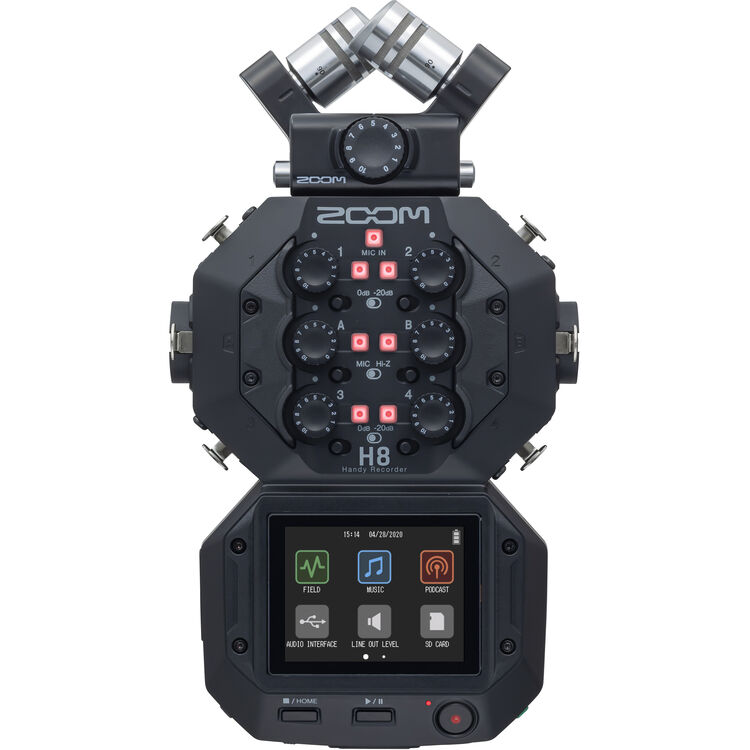
Overview of features and specs
At its core, the Zoom H8 is a multitrack recorder with multiple input sources and six (6) mechanical knobs to control the input gain of each individual source. I like the fact that those knobs represent the full range, will a full stop at the minimum and maximum position (unlike some devices whose knobs spin infinitely, even after surpassing the minimum or maximum gain). I also like the fact the they have numbers painted on the knobs. However, we must be aware that these knobs control software potentiometers (“pots”) which can be overridden by the touchscreen interface. When you do that, the physical knobs are not motorized to match the new setting and therefore (if you use the touchscreen interface to adjust gain a a particular input), the current setting on the knob will no longer reflect the current gain setting. That said, as soon as you move any physical gain knob, that potentiometer again jumps back to match and be controlled by the knob. This is fine once we understand it.
Of course, I love that the H8 can record proper 48 kHz sampling frequency and 24-bit resolution (see 48kHzAllance.com and also my 2015 article Understanding 24-bit vs 16-bit audio production & distribution) in addition to higher sampling frequencies like 96 kHz (which —for the human voice— I can only justify if you plan to use slow motion audio in post) and lower ones that I don’t recommend at all, no matter what, not even for recording audio for virtual PBX/IVR interactive telephony production, as explained mathematically at 48KhzAlliance.com.
Inputs:
- 6 balanced XLR inputs, of which 2 are combo jacks for 1/4” for unbalanced instrument or line input. Each one has switchable phantom power (for condenser mics or external pre-preamps… although you’ll probably never need one of those with the H8 given how clean and powerful the H8’s preamps are) and a switchable -20 dB pad for very loud sources.
- Proprietary Zoom Capsule System 2.0 connector, which can add up to 4 additional audio channels, for a potential total of 10 with the optional EXH-8 module (each with an XLR balanced input, with switchable phantom power). The H8 works with the included XYH-6 microphone (pair of unidirectional mics, usable as stereo with 90 or 120 degrees, or dual mono) which also has a 3.5 mm stereo unbalanced input for unbalanced electret mics or unbalanced dynamic mics. This 3.5 mm input overrides the pair of unidirectional mics and shares the knob to control control input gain of that source. Many other capsules are available (or coming soon) from Zoom.
Outputs:

- 3.5 mm stereo TRS unbalanced line output with adjustable output level via the touchscreen, and even a tone generator to facilitate matching levels when feeding a camcorder’s audio input.
- 3.5 mm stereo TRS unbalanced headphone output with adjustable output volume via the touchscreen. (Although there is no physical knob for headphone volume, after you plug in your headphones, access is almost always available in the upper right corner of the touchscreen.)
- Internal mono speaker for low-quality confidence playback
- Transceiver port for optional bluetooth module (iOS-only at publication time of this article) to remotely monitor levels and transport controls
Preamps:
Fortunately, the preamps in the H8 have been improved to be cleaner than the earlier H6 model (which obviously makes it even better than the preamps in the H5 which I used to own). My understanding is that the actual gain in the H8’s internal preamps is the same +55.5 dB as the H6 but (unlike the H5 or H6) without the hiss at maximum amplification. Although I don’t own a Shure SM7b (the most gain-hungry dynamic microphone I know), my colleague Curtis Judd tested the H8 with an SM7B in his review and he found it to be clean at maximum gain with a more than healthy level. In my own test you’ll hear ahead, I used a new studio dynamic microphone (to be reviewed separately). (Curtiss Judd has been my guest twice so far on BeyondPodcasting .)
Internal recording:
- SD, SDHC or SDXC card slot
Power:
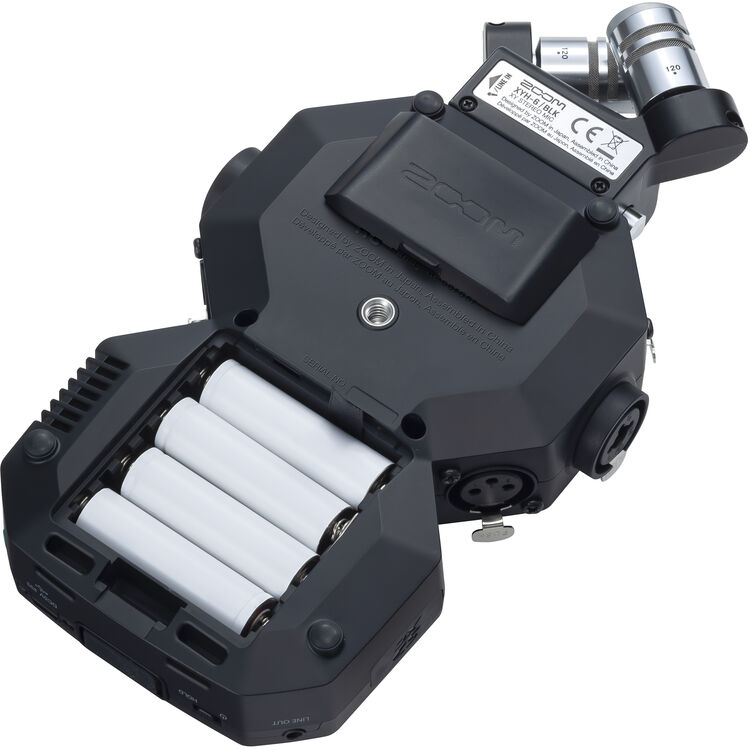
- Compartment for 4 AA batteries
- External power via USB, with automatic fallback from the internal batteries to the external power, without stopping the current operation
- The H8 is bus-powered via USB when connected to a standard computer with macOS or Windows.
Use as an audio interface via the same USB:
- Mulitrack (up to 10 individual tracks + stereo mix = 12) or just stereo mix. Note that at present, multitrack is only available vía macOS and Windows, not with Android, iOS or iPadOS.
- Stereo for iOS, iPadOS, macOS and Windows
Bulletproof and strong latency-free monitoring
The H8’s 3.5 mm jack for monitoring is designed to be used with TRS stereo headphones and even works with TRRS headsets with a microphone included. The H8 is fortunately designed to ignore the microphone on a TRRS headset, if present, while outputting the latency-free audio.
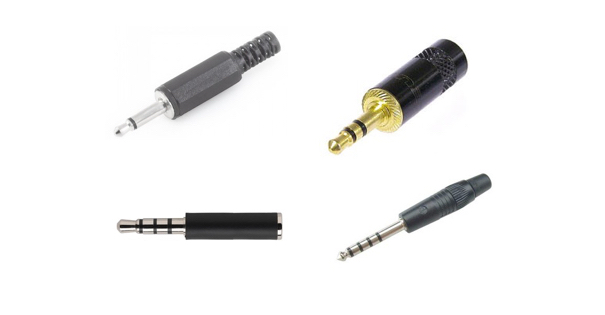
I call it bulletproof since it solves the issue discussed in my 2015 article TS/TRS/TRRS/TRRRS: Combating the misconnection epidemic (illustrated above).
The signal from this 3.5 mm output is very clean compared to the one I recall from the H5. Unlike some other devices I have tested recently (which have a much weaker headphone amplifier), using my Status Audio CB-1 isolating headphones (which are rated at 32 ohms), the output level in my headphones fortunately was great even at about 70% on the headphone volume when recording at -12 dB. Since the headphone amplifier in the H8 is so powerful, even the popular Sony MDR-7506 headphone (officially 63 ohms, although Ken Rockwell measured it to be even higher) should work fine.
The same 3.5 mm jack also works just as well for playback monitoring from the H8… or from your connected computer when using the USB Interface mode, as long as your app and/or system are set to send audio playback to the H8.
Some reviewers have criticized the fact that the H8 has a single headphone output.
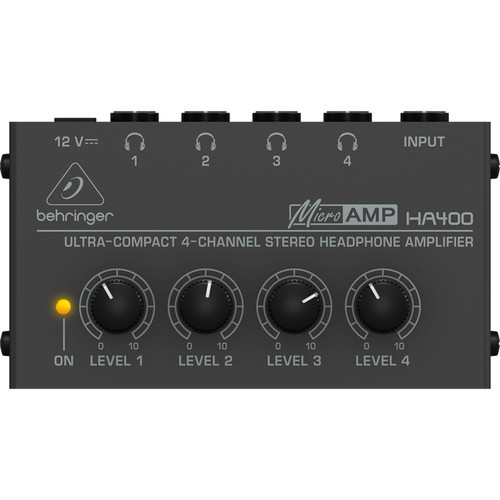
That is easily solved. To connect the single headphone output to up to four individuals, you can use something like the Behringer Micr AMP HA-400 headphone distribution amplifier ≈US$24. A single 3.5 mm to 1/4” stereo TRS cable would connect the distribution amplifier to the H8. Then each output can feed each headphone or in-ear IFB type earset. Each one will have its own level adjustment.
Three powerful apps with inappropriate names
The current firmware of the H8 includes three powerful apps for different types of productions. Generally speaking, I like the apps and the way they work, but i believe they should be named differently to allow content producers to better understand and take advantage of them. This is certainly not a reason not to consider purchasing the H8 or to use the apps, but simply a better way to understand them and their possible uses (and a suggestion to Zoom to rename them in a future firmware update).
App 1: “Field”
If you have your UI (user interface) set to be in English, the first app is currently named “Field”. (If you have it set to be in Castilian, then it’s currently named named “Exterior” which is indeed a proper translation of the inappropriate name “Field” in this case.) I would have called this app “Standard” or “Typical”. I object to the term “Field” since I would use this first app even “in studio” for any multitrack recording (or live broadcast) situation where I didn’t need inboard virtual carts (aka “sound pads”) inside of the H8. If you have a spare audio player of any type (i.e. an iPod, iPod Touch, iPad or Android device), you could plug it into one of the available H8 inputs (like one of the 1/4” inputs or the the 3.5 mm input of the included XYH-6 module) and then take more advantage of the so-called “Field” app, which includes the pre-record option and simultaneous level meters for each input, both of which are missing from the “Podcast” app due to “real estate” (screen space) allocations.
I’ll clarify that if you want to use external virtual carts which are true stereo, then the simplest way to connect them will be to connect via the included XYH-6’s 3.5 mm input, since otherwise, it would occupy not one but two of the H8’s 1/4 inputs, A and B, which would also require occupying two inputs. On the other hand, if your external virtual carts are mono, then you could connect them only to A or B’s 1/4” input with a single cable. If you do use the input in the XYH-6’s 3.5 mm input, be sure to set the volume quite low on your external player (like 20%) or use an attenuating cable since this input is expecting mic level, not line level.
App 2: “Music”
For post mixing and overdubbing, including a metronome. As indicated in the introductory paragraph, I am only covering musical production very superficially in this review. Also, please note that the official Zoom H8 manual sadly states on page 94:
“Effects can only be used when the recording format is 44.1 kHz/16-bit WAV or 44.1 kHz/24-bit WAV.”
This means that these effects in the Music app are inappropriate and non-standard for proper video productions, as explained in 48kHzAlliance.com. This might be a dealbreaker for some producers who need to create in 48 kHz and want to do effects within the H8, but not for those who add effects using a separate app on a computer (which is what I do).
App 3: “Podcast”
The industry term “Podcast” refers to serial distribution and syndication with RSS subscription, not to any particular type of a production per se. That’s why I strongly object to the misuse of the industry term “Podcast” as the name of this app in the H8. The main attraction of this misnamed app within the H8 is its offering of virtual carts (aka “sound pads”) and has noting to do with any type of distribution. They probably chose the name because it being a marketing buzzword, but it really misrepresents its true functionality. This powerful app is equally appropriate for use with any type of live production where it is desired to play pre-recorded sounds, be they openings, bumpers, stingers, sound effects, commercial spots or a closing. All of those apply equally to live radio, live TV or live-to-drive (previously known as “live-to-tape”). So the short name I would give to this powerful app would be “Live”.
Although the virtual carts in the so-called “Podcast” app in the H8 fortunately do accept 48 kHz audio files, please note that when using this app, you immediately lose two of the six inboard XLR inputs. This is because the virtual carts (aka “sound pads”) occupy two recording tracks. I believe that for many productions, four local mic sources is often plenty. If you really need more than the remaining four mic inputs and really want to use the “Podcast” app because of the inboard virtual carts, you can use any of the attached microphones which attach to the module port, be it the included XYH-6 microphone or the optional EXH-8 module, which adds four additional XLR inputs. However, if you want to use virtual carts and already own any type of external audio player, I would instead recommend using the so-called “Field” app and connect it as described in that section above to your external player. That way, you’’ill get more power in the H8 recorder itself, including the individual level meter for each sound source displayed simultaneously, a better use of the “real estate” on the touchscreen and the potential use of the pre-record option: Instead of pressing the touchscreen on the H8 to play a virtual cart, you’ll press it on your external player, as indicated above.
Apparently missing in the H8 recorder as of publication time of this article is any option for mix-minus. You’ll see that in my suggestions in the Conclusions section.
Filter + Compressor, Limiter or Noise Gate
With each input, we get to have an adjustable low cut filter (aka high pass filter) to cut rumble. This is very important and valuable feature
In addition, we have the option of:
- Compressor
- Limiter
- Noise Gate
There are all properly translated if you set the H8 to be in Castilian as:
- Compresor
- Limitador
- Puerta de ruidos
Each one gives us deeper control. The only important limitation to understand is that we can only choose one of these three things per input.
Test recording
The below recording is uncompressed 48 kHz WAV. Use Ethernet, wifi or unmetered data.
It is flat, without any equalization, filtration or compression. It is only normalized.
If you would like to hear the results of another finished recording made with the same dynamic microphone via H8’s preamp and A-to-D conversion after audio post-processing, check out the video in this recent article: Review: YoloBox touchscreen video switcher-recorder-streaming encoder.
Timecode in the H8?
Timecode is not a feature in the H8 as it is in some higher priced models from Zoom and Sound Devices. However, Tentacle Sync has documented a way to connect and record timecode on a track on the much cheaper Zoom H4n recorder, which is much less capable than the H8 in many respects. I am not trying to say that the clock accuracy of the H8 will be as precise as in a higher end recorder made to record timecode with external sync. What I am saying is that if your audio recorder budget is ≈US$400 and you require matching timecode just to facilitate auto-syncing hundreds of audio clips with hundreds of video clips in DaVinci Resolve (i.e. for a documentary produced in dual system), you should consider looking into Tentacle Sync’s documentation for doing it with the H4n and apply it to the H8.
How to read the touchscreen in bright sunlight?
The color touchscreen on the H8 works very well indoors. However, outdoors it’s nearly impossible to see. I recommend the use of a black focusing cloth (made for large-format cameras), a black pillowcase or a black t-shirt to solve this problem when using the H8 outdoors.
Ratings
Looks and build quality

Sound quality

(in its price range)
Zero-latency, bulletproof monitoring

48 kHz/24-bit recording and interfacing capability

Operability as audio interface with macOS and Windows

Operability audio interface with Android, iOS, iPadOS

(Multitrack is currently not available for these operating systems, only stereo.)
Indoor operability of touchscreen

Outdoor use of the touchscreen

Use the workaround I cover in the article.
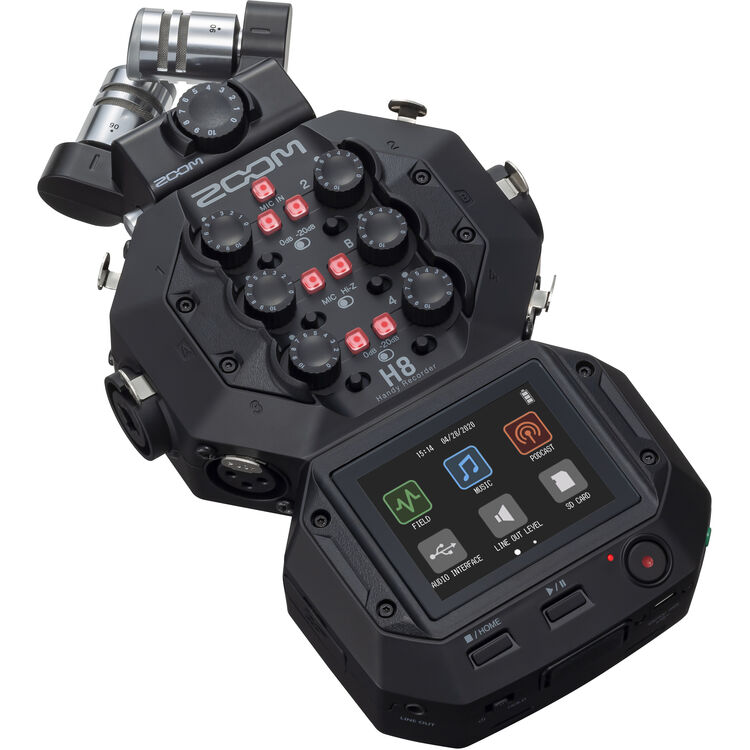
Photo credits
Some photographs in this review are courtesy of Zoom and one from Behringer.
Conclusions and suggestions
I consider the H8 to be a very good offering within its price range. I love its appearance, ease of operation, physical knobs for input gain, and the capability of seeing independent inputs on separate level meters in the Field app. I would definitely recommend it as is, and even more if Zoom accepts my suggestions for improvements in future updates.
- In a future firmware update to the H8, Zoom should add a mix-minus option for the line output. It should be selectable in the menu for a particular input (i.e. A or B since they have a 1/4” line input).
- In a future firmware update to the H8, Zoom should rename the app currently called “Field” app to be named “Standard” or “Typical” as explained earlier in this article.
- In a future firmware update to the H8, Zoom should rename the app currently called “Podcast” app to be named “Live” as explained earlier in this article.
Be sure to be on my free mailing list to be notified about the upcoming review of the new dynamic studio microphone used for this article, and any future ones.
(Re-)Subscribe for upcoming articles, reviews, radio shows, books and seminars/webinars
Stand by for upcoming articles, reviews, books and courses. Sign up to my free mailing list by clicking here. If you previously subscribed to my bulletins and no longer receive them, you must re-subscribe due to new compliance to GDPR. Most of my current books are at books.AllanTepper.com, and my personal website is AllanTepper.com. Also visit radio.AllanTepper.com.
Si deseas suscribirte (o volver a suscribirte) a mi lista en castellano, visita aquí. Si prefieres, puedes suscribirte a ambas listas (castellano e inglés).
Suscribe to my BeyondPodcasting show in English or CapicúaFM en castellano.
FTC disclosure
No manufacturer is specifically paying Allan Tépper or TecnoTur LLC to write this article or the mentioned books. Some of the other manufacturers listed above have contracted Tépper and/or TecnoTur LLC to carry out consulting and/or translations/localizations/transcreations. Many of the manufacturers listed above have sent Allan Tépper review units. So far, none of the manufacturers listed above is/are sponsors of the TecnoTur , BeyondPodcasting CapicúaFM or TuSaludSecreta programs, although they are welcome to do so, and some are, may be (or may have been) sponsors of ProVideo Coalition magazine. Some links to third parties listed in this article and/or on this web page may indirectly benefit TecnoTur LLC via affiliate programs. Allan Tépper’s opinions are his own. Allan Tépper is not liable for misuse or misunderstanding of information he shares.
Copyright and use of this article
The articles contained in the TecnoTur channel in ProVideo Coalitionmagazine are copyright Allan Tépper/TecnoTur LLC, except where otherwise attributed. Unauthorized use is prohibited without prior approval, except for short quotes which link back to this page, which are encouraged!

Filmtools
Filmmakers go-to destination for pre-production, production & post production equipment!
Shop Now












